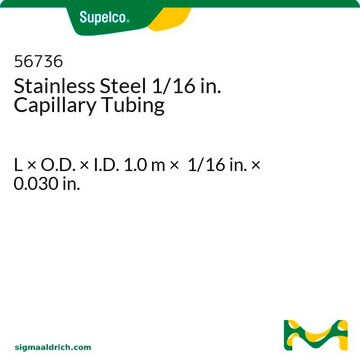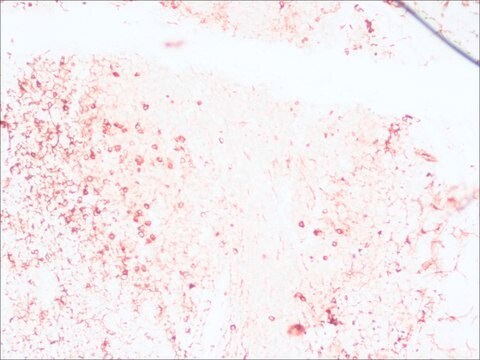MABN2421
Anti-Beta (β)-Amyloid antibody
mouse monoclonal, Mhj7.4
Synonyme(s) :
Ab42, Amyloid peptide 1-42
About This Item
Produits recommandés
Nom du produit
Anti-Amyloid β 1-42 Antibody, clone mHJ7.4, clone mHJ7.4
Source biologique
mouse
Niveau de qualité
Forme d'anticorps
purified antibody
Clone
mHJ7.4, monoclonal
Poids mol.
4.51 kDa (for Amyloid 1-42 peptide; 86.94 kDa calculated for Amyloid Precursor Protein.)
Produit purifié par
using protein G
Espèces réactives
human
Isotype
IgG2bκ
Numéro d'accès
NP_000475
Numéro d'accès UniProt
Description générale
Processing of APP occurs by two major pathways cleavage of APP by a-secretase is a non-amyloidogenic pathway and does not produce Aβ peptides. Cleavage of APP at the N-terminus of the Aβ region by β-secretase and at the C-terminus by g-secretase represents the amyloidogenic pathway. The β-secretase cleaves APP between residues Met671 and Asp672 and yields sAPPβ and C99. Following the β-secretase cleavage, a second cleavage occurs at the C-terminus of Aβ peptide that releases Aβ from C99. This cleavage occurs in the vicinity of residue 712 of the C-terminus. The g-secretase can cleave the C-terminal region at either Val711 or Ile713 to produce the shorter Aβ peptide (Aβ1-40) or the longer Aβ peptide (Aβ1-42), respectively.
The predominant form of Aβ found in the cerebrospinal fluid is the shorter Aβ1-40 peptide. Despite its lower rate of synthesis, Aβ1-42 is the peptide that is initially deposited within the extracellular plaques of AD patients. In addition, Aβ1-42 is more hydrophobic and aggregates at much lower concentration than the Aβ1-40 form. The abnormal accumulation of Aβ peptides can result in neuronal damage and loss by increasing free radical production and activation of inflammatory pathways by enhancing microglial secretion of inflammatory cytokines. Interaction between Aβ and ApoE3 or E4 is also an important determinant of amyloidosis. ApoE3 is shown to inhibit Aβ aggregation in vitro by decreasing Aβ multimers, whereas ApoE4 is reported to accelerate the rate of amyloid fibril formation.
Spécificité
Immunogène
Application
Note: Actual optimal working dilutions must be determined by end user as specimens, and experimental conditions may vary with the end user
Qualité
Reconstitution
Stockage et stabilité
Autres remarques
Clause de non-responsabilité
Code de la classe de stockage
12 - Non Combustible Liquids
Classe de danger pour l'eau (WGK)
WGK 1
Point d'éclair (°F)
Not applicable
Point d'éclair (°C)
Not applicable
Certificats d'analyse (COA)
Recherchez un Certificats d'analyse (COA) en saisissant le numéro de lot du produit. Les numéros de lot figurent sur l'étiquette du produit après les mots "Lot" ou "Batch".
Déjà en possession de ce produit ?
Retrouvez la documentation relative aux produits que vous avez récemment achetés dans la Bibliothèque de documents.
Notre équipe de scientifiques dispose d'une expérience dans tous les secteurs de la recherche, notamment en sciences de la vie, science des matériaux, synthèse chimique, chromatographie, analyse et dans de nombreux autres domaines..
Contacter notre Service technique








